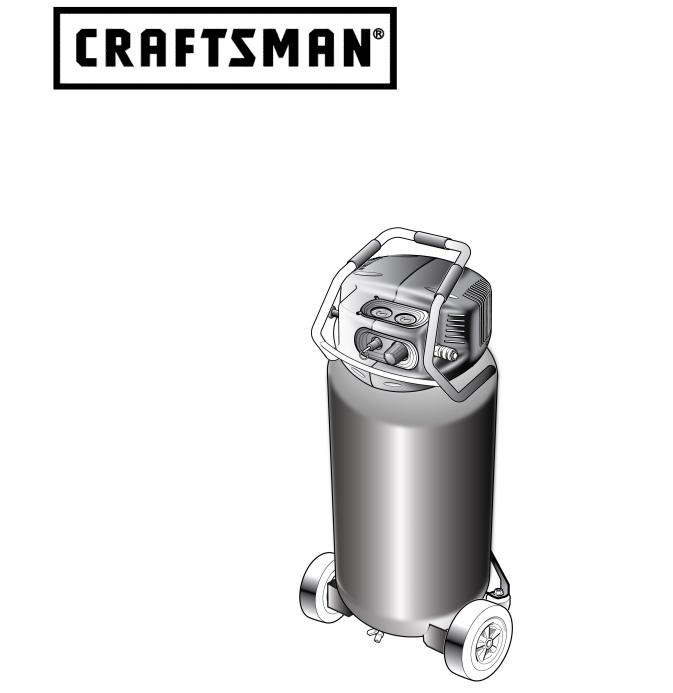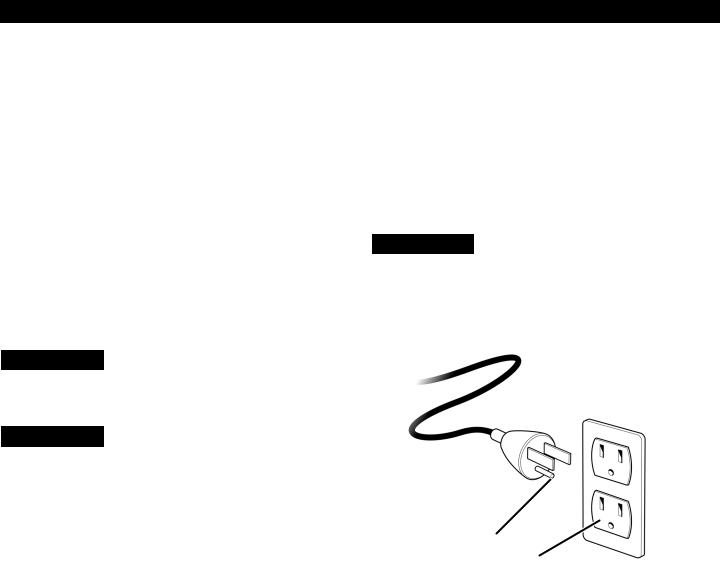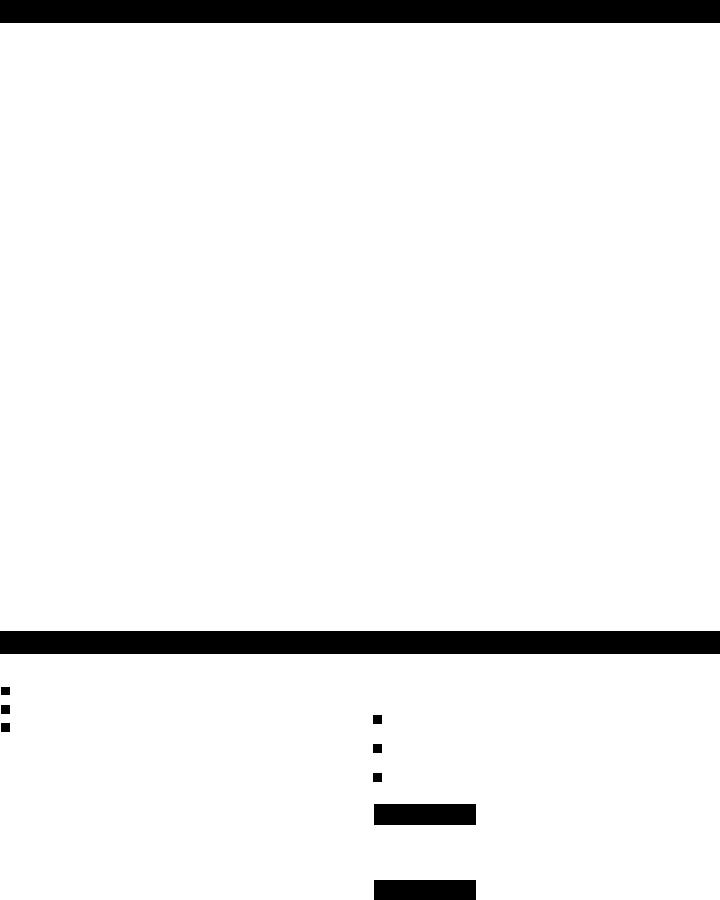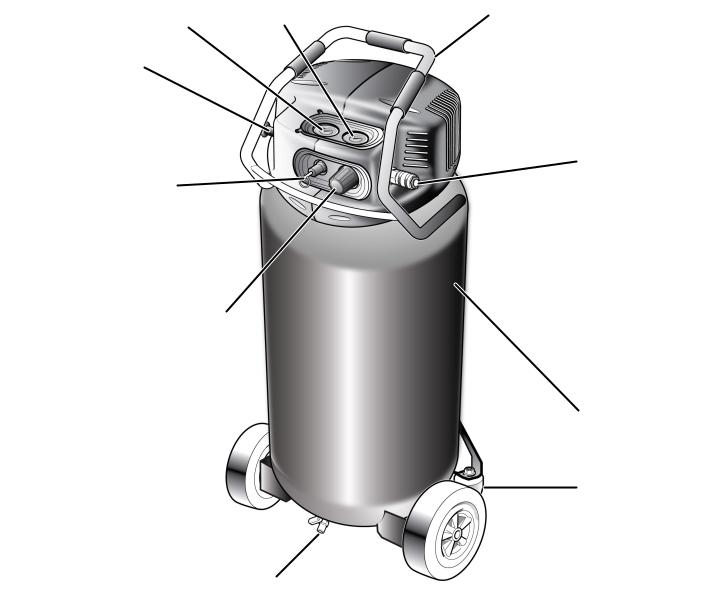Craftsman 16957, 10716957 Owner’s Manual

Operator’s Manual
AIR COMPRESSOR
20 Gallon Oil Free Portable Air Compressor
Model No. 107.16957
CAUTION: |
• |
Safety Instructions |
Before using this product, |
• |
Assembly & Operation |
read this manual and follow |
• |
Maintenance |
all its Safety Rules and |
• |
Troubleshooting Guide |
Operating Instructions. |
• |
Storage |
|
• |
Parts List |
|
• |
Español, p. 15 |
Sears Brands Management Corporation, Hoffman Estates, IL 60179 U.S.A. www.craftsman.com
6/19/2017
Part No. 9041993

TABLE OF CONTENTS
WARRANTY ............................................................................. |
2 |
SPECIFICATIONS ................................................................... |
2 |
SAFETY SYMBOLS ................................................................. |
3 |
GENERAL SAFETY INSTRUCTIONS .................................. |
3-4 |
SPECIFIC SAFETY INSTRUCTIONS ................................... |
4-5 |
ELECTRICAL SAFETY ............................................................ |
6 |
Extension Cords ............................................................... |
6 |
Electrical Connection ........................................................ |
6 |
Speed and Wiring ............................................................. |
6 |
Grounding Instructions ...................................................... |
6 |
GLOSSARY ............................................................................. |
7 |
PACKING ................................................................................. |
7 |
Packing list ........................................................................ |
7 |
Unpacking ......................................................................... |
7 |
OVERVIEW .............................................................................. |
8 |
Know your Air Compressor ............................................... |
8 |
ASSEMBLY .............................................................................. |
9 |
Assembling the rubber feet and wheels............................. |
9 |
Attaching hose and quick coupler...................................... |
9 |
OPERATION .......................................................................... |
10 |
Breaking in the pump ...................................................... |
10 |
Applications .................................................................... |
10 |
How to use your Air Compressor .................................... |
10 |
Draining the Tank ............................................................. |
11 |
Checking the Safety Valve ............................................... |
11 |
MAINTENANCE ..................................................................... |
12 |
General Maintenance ..................................................... |
12 |
Lubrication ...................................................................... |
12 |
STORAGE .............................................................................. |
12 |
TROUBLESHOOTING ........................................................... |
13 |
PARTS LIST ........................................................................... |
14 |
WARRANTY
CRAFTSMAN LIMITED WARRANTY
FOR ONE YEAR from the date of sale this product is warranted against defects in material or workmanship.
WITH PROOF OF SALE a defective product will receive free repair. If the product cannot be repaired it will be replaced free of charge.
For warranty coverage details to obtain free repair, visit the web page: www.craftsman.com/warranty
This ONE YEAR warranty is void if this product is ever used while providing commercial services or if rented to another person. For 90 DAY commercial and rental use terms, see the Craftsman warranty web page.
This warranty gives you specific legal rights, and you may also have other rights which vary from state to state.
Sears Brands Management Corporation, Hoffman Estates, IL 60179
SPECIFICATIONS
Running Horsepower |
.........................................................1.8 HP |
Air Tank Capacity ......................................................... |
20 gallons |
Air Pressure ............................................................ |
155 PSI max. |
Air Delivery ................................................... |
4.3 SCFM @ 90 PSI |
...................................................................... |
6.1 SCFM @ 40 PSI |
Lubrication |
........................................................................ |
Oil-Free |
Gauges ................................................................. |
|
2.0 in. diameter |
Input ........................................ |
|
120 V, 60 Hz, AC only, 13.5 Amps |
Net Weight ............................................(compressor only) |
83 lbs. |
|
Duty Cycle.......................... |
50% (5 minutes ON / 5 minutes OFF) |
|
2

SAFETY SYMBOLS
The information listed below should be read and understood by the operator. This information is given to protect the user while operating and storing the air compressor. We utilize the symbols below to allow the reader to recognize important information about their safety.
|
|
|
|
|
|
|
|
|
|
DANGER |
|
|
|
|
CAUTION |
|
|
Indicates an imminently hazardous situation, which, if not |
Indicates a potentially hazardous situation, which, if not avoided, |
|||||||
avoided, will result in death or serious injury. |
may result in minor or moderate injury. |
|||||||
|
|
|
|
|
|
|||
|
WARNING |
|
|
|
CAUTION |
|
||
Indicates a potentially hazardous situation, which, if not avoided, |
(Without Safety Alert Symbol) Indicates a situation that may |
|||||||
could result in death or serious injury. |
result in property damage. |
|||||||
GENERAL SAFETY INSTRUCTIONS
 WARNING
WARNING
Read and understand all instructions. Failure to follow all instructions listed below may result in electric shock, fire, and/or serious personal injury.
SAVE THESE INSTRUCTIONS
WORK AREA
 Keep your work area clean and well lit. Cluttered benches and dark areas invite accidents. The floor must not be slippery from wax or dust.
Keep your work area clean and well lit. Cluttered benches and dark areas invite accidents. The floor must not be slippery from wax or dust.
 Do not operate power tools in explosive atmo-spheres, such as in the presence of flammable liquids, gases, or dust. Power tools create sparks which may ignite the dust or fumes.
Do not operate power tools in explosive atmo-spheres, such as in the presence of flammable liquids, gases, or dust. Power tools create sparks which may ignite the dust or fumes.
 Keep bystanders, children, and visitors away while operating tools. Distractions can cause you to lose control.
Keep bystanders, children, and visitors away while operating tools. Distractions can cause you to lose control.
 Operate the air compressor in an open area at least 18 in. away from any wall or object that could restrict the flow of fresh air to ventilation openings.
Operate the air compressor in an open area at least 18 in. away from any wall or object that could restrict the flow of fresh air to ventilation openings.
ELECTRICAL SAFETY
 Avoid body contact with grounded surfaces such as pipes, radiators, ranges, and refrigerators. There is an increased risk of electric shock if your body is grounded.
Avoid body contact with grounded surfaces such as pipes, radiators, ranges, and refrigerators. There is an increased risk of electric shock if your body is grounded.
 Don’t expose power tools to rain or wet conditions. Water entering a power tool will increase the risk of electric shock.
Don’t expose power tools to rain or wet conditions. Water entering a power tool will increase the risk of electric shock.
 Do not abuse the cord. Never use the cord to carry the tool or pull the plug from an outlet. Keep the cord away from heat, oil, sharp edges, or moving parts. Replace damaged cords immediately. Damaged cords increase the risk of electric shock.
Do not abuse the cord. Never use the cord to carry the tool or pull the plug from an outlet. Keep the cord away from heat, oil, sharp edges, or moving parts. Replace damaged cords immediately. Damaged cords increase the risk of electric shock.
 When operating a power tool outside, use an outdoor extension cord marked “W-A” or “W”. These cords are rated for outdoor use and reduce the risk of electric shock.
When operating a power tool outside, use an outdoor extension cord marked “W-A” or “W”. These cords are rated for outdoor use and reduce the risk of electric shock.
PERSONAL SAFETY
 Eye protection which conforms to ANSI specifications and provides protection against flying particles both from the FRONT and SIDE should ALWAYS be worn by the operator and others in the work area when loading, operating, or servicing this tool. Eye protection is required to guard against flying fasteners and debris, which could cause severe eye injury.
Eye protection which conforms to ANSI specifications and provides protection against flying particles both from the FRONT and SIDE should ALWAYS be worn by the operator and others in the work area when loading, operating, or servicing this tool. Eye protection is required to guard against flying fasteners and debris, which could cause severe eye injury.
 WARNING
WARNING
The brass components of this product contain lead, a chemical known to the state of California to cause birth defects (or other reproductive harm).
(California health & safety code § 25249.5, et seq.)
 The employer and/or user must ensure that proper eye protection is worn. We recommend a Wide Vision Safety Mask for use over eyeglasses or standard safety glasses that provide protection against flying particles both from the front and side. Always use eye protection which is marked to comply with ANSI Z87.1.
The employer and/or user must ensure that proper eye protection is worn. We recommend a Wide Vision Safety Mask for use over eyeglasses or standard safety glasses that provide protection against flying particles both from the front and side. Always use eye protection which is marked to comply with ANSI Z87.1.
 Additional safety protection will be required in some environments. For example, the working area may include exposure to a noise level which can lead to hearing damage. The employer and user must ensure that any necessary hearing protection is provided and used by the operator and others in the work area. Some environments will require
Additional safety protection will be required in some environments. For example, the working area may include exposure to a noise level which can lead to hearing damage. The employer and user must ensure that any necessary hearing protection is provided and used by the operator and others in the work area. Some environments will require
the use of head protection equipment. When required, the employer and user must ensure that head protection marked to comply with ANSI Z89.1 is used.
 Stay alert, watch what you are doing, and use common sense when operating a power tool. Do not use tools while tired or under the influence of drugs, alcohol, or medication. A moment of inattention while operating power tools may result in serious personal injury.
Stay alert, watch what you are doing, and use common sense when operating a power tool. Do not use tools while tired or under the influence of drugs, alcohol, or medication. A moment of inattention while operating power tools may result in serious personal injury.
 Dress properly. Do not wear loose clothing or jewelry. Contain long hair. Keep your hair, clothing, and gloves away from moving parts. Loose clothes, jewelry, or long hair can be caught in moving parts.
Dress properly. Do not wear loose clothing or jewelry. Contain long hair. Keep your hair, clothing, and gloves away from moving parts. Loose clothes, jewelry, or long hair can be caught in moving parts.
 Do not overreach. Keep proper footing and balance at all times. Proper footing and balance enables better control of the tool in unexpected situations.
Do not overreach. Keep proper footing and balance at all times. Proper footing and balance enables better control of the tool in unexpected situations.
 Use safety equipment. Always wear eye protection. A dust mask, nonskid safety shoes, hard hat, or hearing protection must be used for appropriate conditions.
Use safety equipment. Always wear eye protection. A dust mask, nonskid safety shoes, hard hat, or hearing protection must be used for appropriate conditions.
 Do not use on a ladder or unstable support. Stable footing on a solid surface enables better control of the tool in unexpected situations.
Do not use on a ladder or unstable support. Stable footing on a solid surface enables better control of the tool in unexpected situations.
TOOL USE AND CARE
 Do not exceed the pressure rating of any component in the system.
Do not exceed the pressure rating of any component in the system.
 Protect material lines and air lines from damage or puncture. Keep the hose and power cord away from sharp objects, chemical spills, oil, solvents, and wet floors.
Protect material lines and air lines from damage or puncture. Keep the hose and power cord away from sharp objects, chemical spills, oil, solvents, and wet floors.
3

 Check hoses for weak or worn condition before each use, making certain all connections are secure. Do not use if a defect is found. Purchase a new hose or take to a qualified service center for examination and repair.
Check hoses for weak or worn condition before each use, making certain all connections are secure. Do not use if a defect is found. Purchase a new hose or take to a qualified service center for examination and repair.
Release the pressure within the system slowly. Dust and debris may be harmful.
Store idle tools out of the reach of children and other untrained persons. Tools are dangerous in the hands of untrained users.
Maintain tools with care. Follow maintenance instructions. Properly maintained tools are easier to control.
 Check for misalignment or binding of moving parts, breakage of parts, and any other condition that may affect the tool’s operation. If damaged, have the tool serviced before using. Many accidents are caused by poorly maintained tools.
Check for misalignment or binding of moving parts, breakage of parts, and any other condition that may affect the tool’s operation. If damaged, have the tool serviced before using. Many accidents are caused by poorly maintained tools.
 Never point any tool toward yourself or others.
Never point any tool toward yourself or others.
 Keep the exterior of the air compressor dry, clean, and free from oil and grease. Always use a clean cloth when
Keep the exterior of the air compressor dry, clean, and free from oil and grease. Always use a clean cloth when
cleaning. Never use brake fluids, gasoline, petroleum-based products, or any strong solvents to clean the unit. Following this rule will reduce the risk of deterioration of the enclosure plastic.
SERVICE
 Tool service must be performed only by qualified repair personnel. Service or maintenance performed by unqualified personnel may result in a risk of injury.
Tool service must be performed only by qualified repair personnel. Service or maintenance performed by unqualified personnel may result in a risk of injury.
 Disconnect the power supply, open the drain valve to decompress the tank and allow water to drain, and allow the air compressor to become cool to the touch before servicing. Turn the pressure regulator knob fully counter clockwise after shutting off the compressor.
Disconnect the power supply, open the drain valve to decompress the tank and allow water to drain, and allow the air compressor to become cool to the touch before servicing. Turn the pressure regulator knob fully counter clockwise after shutting off the compressor.
 When servicing a tool, use only identical replacement parts. See Parts List in this manual. Follow the instructions in the Maintenance section of this manual.
When servicing a tool, use only identical replacement parts. See Parts List in this manual. Follow the instructions in the Maintenance section of this manual.
Use of unauthorized parts or failure to follow the Maintenance instructions may create a risk of injury.
|
|
|
|
|
SPECIFIC SAFETY INSTRUCTIONS |
|
|
|
|
||
|
WARNING |
|
|
||
|
|
|
|
|
|
|
|
|
Read the operator’s |
Know your power tool. Read the operator’s manual carefully. Learn its applications and limita- |
|
|
|
|
tions, as well as the specific potential hazards related to this tool. Following this rule will reduce |
||
|
|
|
manual |
the risk of electric shock, fire, or serious injury. |
|
|
|
|
|
|
|
|
|
|
|
|
|
|
|
|
|
|
The operation of any power tool can result in foreign objects being thrown into your eyes, which |
|
|
|
Eye protection |
can result in severe eye damage. Before beginning power tool operation, always wear safety |
|
|
|
|
goggles, safety glasses with side shields, or a full face shield when needed. We recommend |
||
|
|
|
|
|
Wide Vision Safety Mask for use over eyeglasses or standard safety glasses with side shields. |
|
|
|
|
|
Always use eye protection which is marked to comply with ANSI Z87.1. |
|
|
|
|
|
|
|
|
|
Risk of Fire or Explo- |
Do not spray flammable liquid in a confined area. The spray area must be well ventilated. Do |
|
|
|
|
not smoke while spraying or spray where sparks or a flame is present. Keep compressors as |
||
|
|
|
sion |
far from the spraying area as possible, at least 15 feet from the spraying area and all explosive |
|
|
|
|
|
|
vapors. |
|
|
|
|
|
|
|
|
|
Risk of Bursting |
Do not adjust the regulator to result in output pressure greater than the marked maximum pres- |
|
|
|
|
sure of the attachment. Do not use at a pressure greater than the rated maximum pressure of |
||
|
|
|
|
|
this compressor. |
|
|
|
|
|
|
|
|
|
Risk of Electrical |
Hazardous voltage: Disconnect from the power source before servicing. The compressor must |
|
|
|
|
Shock |
be grounded. |
|
|
|
|
|
|
|
|
|
|
Hot Surface |
To reduce the risk of injury or damage, avoid contact with any hot surface. |
|
|
|
|
|
|
|
|
|
|
Risk to Hearing |
Always wear ear protection when using this tool. Failure to do so may result in hearing loss. |
|
|
|
|
|
|
|
|
|
|
Risk to Breathing |
Air obtained directly from the air compressor should never be used to supply air for human |
|
|
|
|
|||
|
|
|
consumption. |
||
|
|
|
|
|
|
|
|
|
|
|
|
|
|
|
|
|
|
|
|
|
Drain Tank |
Drain the tank of moisture after each day’s use. If the unit will not be used for a while, it is best |
|
|
|
|
to leave the drain valve open until such time as it is to be used. This will allow moisture to com- |
||
|
|
|
|
|
pletely drain out and help prevent corrosion on the inside of tank. |
|
|
|
|
|
|
4

 CAUTION
CAUTION
If connected to a circuit protected by fuses, use time-delay fuses with this product.
 To reduce the risk of electric shock, do not expose to rain. Store indoors.
To reduce the risk of electric shock, do not expose to rain. Store indoors.
 Inspect the tank yearly for rust, pin holes, or other imperfections that could cause it to become unsafe. Never weld or drill holes in the air tank.
Inspect the tank yearly for rust, pin holes, or other imperfections that could cause it to become unsafe. Never weld or drill holes in the air tank.
 Make sure the hose is free of obstructions or snags.
Make sure the hose is free of obstructions or snags.
Entangled or snarled hoses can cause loss of balance or footing and may become damaged.
 Use the air compressor only for its intended use. Do not alter or modify the unit from the original design or function.
Use the air compressor only for its intended use. Do not alter or modify the unit from the original design or function.
Always be aware that misuse and improper handling of this tool can cause injury to yourself and others.
 Never leave a tool unattended with the air hose attached.
Never leave a tool unattended with the air hose attached.
 Do not operate this tool if it does not contain a legible warning label.
Do not operate this tool if it does not contain a legible warning label.
 Do not continue to use a tool or hose that leaks air or does not function properly.
Do not continue to use a tool or hose that leaks air or does not function properly.
Always disconnect the air supply and power supply before making adjustments, servicing a tool, or when a tool is not in use.
 Do not attempt to pull or carry the air compressor by the hose.
Do not attempt to pull or carry the air compressor by the hose.
 Your tool may require more air consumption than this air compressor is capable of providing.
Your tool may require more air consumption than this air compressor is capable of providing.
 When a combustible liquid is sprayed there can be danger of fire or explosion, especially in a closed area. Read instruction manual before operating.
When a combustible liquid is sprayed there can be danger of fire or explosion, especially in a closed area. Read instruction manual before operating.
Arcing parts. Use spray gun hose at least 7.6 m long and keep the compressor/motor at least 6 m away from explosive vapours.
Always follow all safety rules recommended by the manufacturer of your tool, in addition to all safety rules for the air compressor. Following these rules will reduce the risk of serious personal injury.
 Never direct a jet of compressed air toward people or animals. Take care not to blow dust and dirt towards yourself or others. Following this rule will reduce the risk of serious injury.
Never direct a jet of compressed air toward people or animals. Take care not to blow dust and dirt towards yourself or others. Following this rule will reduce the risk of serious injury.
Protect your lungs. Wear a face or dust mask if the operation is dusty. Following this rule will reduce the risk of serious personal injury.
 Do not use this air compressor to spray chemicals. Your lungs can be damaged by inhaling toxic fumes. A respirator may be necessary in dusty environments or when spraying paint. Do not carry while painting.
Do not use this air compressor to spray chemicals. Your lungs can be damaged by inhaling toxic fumes. A respirator may be necessary in dusty environments or when spraying paint. Do not carry while painting.
 Inspect tool cords and hoses periodically and, if damaged, have repaired at a qualified service center.
Inspect tool cords and hoses periodically and, if damaged, have repaired at a qualified service center.
Constantly stay aware of cord location. Following this rule will reduce the risk of electric shock or fire.
 Never use an electrical adaptor with this grounded plug.
Never use an electrical adaptor with this grounded plug.
 Check damaged parts. Before further use of the air compressor or air tool, a guard or other part that is damaged should be carefully checked to determine that it will operate properly and perform its intended function. Check for alignment of moving parts, binding of moving parts, breakage of parts, mounting, and any other conditions that may affect its operation. A guard or
Check damaged parts. Before further use of the air compressor or air tool, a guard or other part that is damaged should be carefully checked to determine that it will operate properly and perform its intended function. Check for alignment of moving parts, binding of moving parts, breakage of parts, mounting, and any other conditions that may affect its operation. A guard or
other part that is damaged should be properly repaired or replaced by a qualified service center. Following this rule will reduce the risk of shock, fire or serious injury.
 Make sure your extension cord is in good condition. When using an extension cord, be sure to use one heavy enough to carry the current your product will draw. A wire gauge size (A.W.G.) of at least 14 is recommended for an extension cord 50 feet or less in length. A cord exceeding 100 feet is not recommended. If in doubt, use the next heavier gauge. The smaller the gauge number, the heavier the cord. An undersized cord will cause a drop in line voltage resulting in loss of power and overheating.
Make sure your extension cord is in good condition. When using an extension cord, be sure to use one heavy enough to carry the current your product will draw. A wire gauge size (A.W.G.) of at least 14 is recommended for an extension cord 50 feet or less in length. A cord exceeding 100 feet is not recommended. If in doubt, use the next heavier gauge. The smaller the gauge number, the heavier the cord. An undersized cord will cause a drop in line voltage resulting in loss of power and overheating.
Save these instructions. Refer to them frequently and use them to instruct others who may use this air compressor. If you loan someone this tool, load them these instructions also.
5

ELECTRICAL SAFETY
EXTENSION CORDS
NOTE: Avoid use of extension cords.
1.For optimum performance, plug the compressor power cord directly into a grounded wall socket. Do not use an extension cord unless absolutely necessary. Instead, use a longer air hose to reach the area where the air is needed.
2.If use of an extension cord cannot be avoided, the cord should be no longer than 50 feet and be a minimum wire size of 12 gauge (AWG). Do not use a 16 or 14 gauge extension cord.
3.Use only a 3-wire extension cord that has a 3-blade grounding plug, and a 3-slot receptacle that will accept the plug on the product. Make sure your extension cord is in good condition. An undersized cord will cause a drop in line voltage, resulting in loss of power and overheating. The smaller the gauge number, the heavier the cord.
4.When working with the air compressor outdoors, use an extension cord that is designed for outside use. This is indicated by the letters “WA” on the cord’s jacket.
5.Before using an extension cord, inspect it for loose or exposed wires and cut or worn insulation.
 WARNING Keep the extension cord clear of the working area. Position the cord so that it will not get caught on lumber, tools, or other obstructions while you are working with a power tool. Failure to do so can result in serious personal injury.
WARNING Keep the extension cord clear of the working area. Position the cord so that it will not get caught on lumber, tools, or other obstructions while you are working with a power tool. Failure to do so can result in serious personal injury.
 WARNING Check the extension cords before each use. If damaged, replace immediately. Never use the air compressor with a damaged cord since touching the damaged area could cause electrical shock resulting in serious personal injury.
WARNING Check the extension cords before each use. If damaged, replace immediately. Never use the air compressor with a damaged cord since touching the damaged area could cause electrical shock resulting in serious personal injury.
NOTE: Use longer air hoses instead of long extension cords. Your air compressor will run better and last longer.
ELECTRICAL CONNECTION
1.This air compressor is powered by a precision built electric motor. It should be connected to a power supply that is 120 volts, 60 Hz, AC only (normal household current).
2.Do not operate this tool on direct current (DC). A substantial voltage drop will cause a loss of power and the motor will overheat. If the air compressor does not operate when plugged into an outlet, double check the power supply.
into a matching outlet that is properly installed and grounded in accordance with all local codes and ordinances.
2.Do not modify the plug provided. If it will not fit the outlet, have the proper outlet installed by a qualified electrician.
3.The conductor with insulation having an outer surface that is green with or without yellow stripes is the equipmentgrounding conductor. If repair or replacement of the electric cord or plug is necessary, do not connect the equipmentgrounding conductor to a live terminal.
4.Check with a qualified electrician or service personnel if the grounding instructions are not completely understood, or if in doubt as to whether the tool is properly grounded.
5.Replace a damaged or worn cord immediately.
 WARNING Improper connection of the equipmentgrounding conductor can result in a risk of electric shock.
WARNING Improper connection of the equipmentgrounding conductor can result in a risk of electric shock.
6.This air compressor is intended for use on a circuit that has an outlet like the one shown in the figure 1. It also has a grounding pin like the one shown. This product must be grounded.
Fig. 1
Grounding pin
120V Grounded outlet
7. Never use an electrical adapter with this grounded plug.
SPEED AND WIRING
1.The no-load speed of the electric motor varies by model and specification. The motor speed is not constant and decreases under a load or with lower voltage. For voltage, the wiring in a shop is as important as the motor’s horsepower rating.
2.A line intended only for lights cannot properly carry a power tool motor. Wire that is heavy enough for a short distance will be too light for a greater distance. A line that can support one power tool may not be able to support two or three tools.
GROUNDING INSTRUCTIONS
1.In the event of a malfunction or breakdown, grounding provides a path of least resistance for electric current to reduce the risk of electric shock. This air compressor is equipped with an electric cord having an equipment-grounding conductor and a grounding plug. The plug must be plugged
6

GLOSSARY
Air Filter
Porous element contained within a metal or plastic housing attached to the compressor cylinder head which removes impurity from the intake air of the compressor.
Air Tank
Cylindrical component which contains the compressed air.
Check Valve
Device that prevents compressed air from flowing back from the air tank to the compressor pump.
Cut-In Pressure
The low pressure at which the motor will automatically restart. This compressor cut-in pressure is 125 ± 5 PSI.
Cut-Off Pressure
The high pressure at which the motor will automatically shut off. This compressor cut-off pressure is 155 ± 5 PSI.
Electric Motor
Device which provides the rotational force necessary to operate the compressor pump.
On/Off Power Switch
Control which turns the air compressor on or off. The pressure switch will not automatically start and control the compressor unless the manual on/off switch is in the ON ( l ) position.
NPT (National Pipe Thread)
National Pipe Thread is a U.S. standard for tapered (NPT) or straight (NPS) threads used to join pipes and fittings.
A thread sealing tape must be used to provide a leak-free seal on pipe threaded connections.
Pressure Regulator Knob
Regulates the outgoing pressure from the air outlet to the tool. It is possible to increase or decrease the pressure at the outlet by adjusting this control knob.
Pressure Switch
Automatically controls the on/off cycling of the compressor. It stops the compressor when the cut-off pressure in the tank is reached and starts the compressor when the air pressure drops below the cut-in pressure.
PSI (Pounds Per Square Inch)
Measurement of the pressure exerted by the force of the air. The actual psi is measured by a pressure gauge on the compressor.
Pump
Produces the compressed air with a reciprocating piston contained within the cylinder.
Regulator Pressure Gauge (Outlet pressure)
Displays the current line pressure. Line pressure is adjusted by rotating the pressure regulator knob.
Safety Valve
Prevents air pressure in the air tank from rising over a predetermined limit.
SCFM (Standard Cubic Feet Per Minute)
A unit of measure of air delivery.
L/min (Liter Per Minute)
A unit of measure of air delivery.
Tank Pressure Gauge
Indicates the pressure in the air tank.
Thermal Overload Switch
Automatically shuts off the compressor if the temperature of the electric motor exceeds a predetermined limit.
Duty Cycle
Duty Cycle refers to a percentage of time which the air compressor can run continuously while performing a task before needing to rest or cool down. Example: A 50% duty Cycle compressor must rest for 5 minutes after running continuously for 5 minutes.
PACKING LIST
Air compressor
Male Quick Coupler Owner’s manual
PACKING
UNPACKING
This product has been shipped completely assembled, except the rubber feet, the two wheels and the quick coupler.
Carefully remove the compressor from the box. Make sure that all items listed in the packing list are included.
Inspect the compressor carefully to make sure no breakage or damage occurred during shipping.
Do not discard the packing material until you have carefully inspected and satisfactorily operated the tool.
 WARNING If any parts are missing do not operate the compressor or air tools until the missing parts are replaced. Failure to do so could result in possible serious personal injury.
WARNING If any parts are missing do not operate the compressor or air tools until the missing parts are replaced. Failure to do so could result in possible serious personal injury.
 WARNING Do not attempt to modify this tool or create accessories not recommended for use with this tool. Any such alteration or modification is misuse and could result in a hazardous condition leading to possible serious personal injury.
WARNING Do not attempt to modify this tool or create accessories not recommended for use with this tool. Any such alteration or modification is misuse and could result in a hazardous condition leading to possible serious personal injury.
7

|
|
OVERVIEW |
|
Fig. 2 |
Tank pressure |
Regulator |
Handle |
|
gauge |
pressure gauge |
|
|
On/Off |
|
|
|
power |
|
|
|
switch |
|
|
Quick
coupler
Safety valve
Pressure regulator knob
Tank
Drain
valve
KNOW YOUR AIR COMPRESSOR (see figure 2)
Before attempting to use this product, familiarize yourself with all operating features and safety rules.
Oil-free universal motor
Your air compressor features permanently lubricated bearings.
Air compressor pump
To compress air, the piston moves up and down in the cylinder. On the down stroke, air is drawn in through the air intake valve while the exhaust valve remains closed. On the upstroke, air is compressed, the intake valve closes and compressed air is forced out through the exhaust valve, into the discharge line, through the check valve and into the air tank.
On/Off power switch
This switch is used to start or stop the air compressor. Moving the switch to the (ON) position will provide automatic power to the pressure switch which will allow the motor to start when the air tank pressure is below the factory set cut-in pressure. When in the (ON) position, the pressure switch stops the motor when the
Rubber
foot
 Wheel
Wheel
air tank pressure reaches the factory set cut-out pressure. Moving the switch to the (OFF) position will remove power from the motor and stop the air compressor.
Pressure regulator knob
Use the pressure regulator knob to adjust the amount of air being delivered through the hose.
The air pressure coming from the air tank is controlled by the regulator knob. Turn the pressure regulation knob clockwise to increase discharge pressure, and counterclockwise to decrease discharge pressure. Follow tool operating instructions for recommended pressure range.
Regulator pressure gauge
The current line pressure is displayed on the regulator pressure gauge. This pressure can be adjusted by rotating the pressure regulator knob.
Safety valve
This valve is designed to prevent system failures by relieving pressure from the system when the compressed air reaches a predetermined level. The valve is preset by the manufacturer and
8
